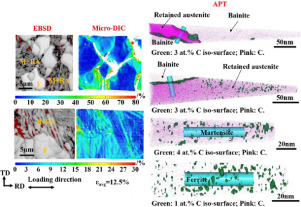当前位置:
X-MOL 学术
›
Acta Mater.
›
论文详情
Our official English website, www.x-mol.net, welcomes your
feedback! (Note: you will need to create a separate account there.)
Joint investigation of strain partitioning and chemical partitioning in ferrite-containing TRIP-assisted steels
Acta Materialia ( IF 8.3 ) Pub Date : 2020-03-01 , DOI: 10.1016/j.actamat.2019.12.050 Xiaodong Tan , Dirk Ponge , Wenjun Lu , Yunbo Xu , Huansheng He , Jun Yan , Di Wu , Dierk Raabe
Acta Materialia ( IF 8.3 ) Pub Date : 2020-03-01 , DOI: 10.1016/j.actamat.2019.12.050 Xiaodong Tan , Dirk Ponge , Wenjun Lu , Yunbo Xu , Huansheng He , Jun Yan , Di Wu , Dierk Raabe

|
Abstract We applied two types of hot-rolling direct quenching and partitioning (HDQ&P) schemes to a low-C low-Si Al-added steel and obtained two ferrite-containing TRIP-assisted steels with different hard matrix structures, viz, martensite or bainite. Using quasi in-situ tensile tests combined with high-resolution electron back-scattered diffraction (EBSD) and microscopic digital image correlation (µ-DIC) analysis, we quantitatively investigated the TRIP effect and strain partitioning in the two steels and explored the influence of the strain partitioning between the soft and hard matrix structures on the TRIP effect. We also performed an atomic-scale analysis of the carbon partitioning among the different phases using atom probe tomography (APT). The results show that the strain mainly localizes in the ferrite in both types of materials. For the steel with a martensitic hard-matrix, a strong strain contrast exists between ferrite and martensite, with the local strain difference reaching up to about 75% at a global strain of 12.5%. Strain localization bands initiated in the ferrite rarely cross the ferrite/martensite interfaces. The low local strain (2%-10%) in the martensite regions leads to a slight TRIP effect with a transformation ratio of the retained austenite of about 7.5%. However, for the steel with bainitic matrix, the ferrite and bainite undergo more homogeneous strain partitioning, with an average local strain in ferrite and bainite of 15% and 8%, respectively, at a global strain of 12.5%. The strain localization bands originating in the ferrite can cross the ferrite/bainite (F/B) interfaces and increase the local strain in the bainite regions, resulting in an efficient TRIP effect. In that case the transformation ratio of the retained austenite is about 41%. The lower hardness difference between the ferrite and bainite of about 178 HV, compared with that between the ferrite and martensite of about 256 HV, leads to a lower strain contrast at the ferrite/bainite interfaces, thus retarding interfacial fracture. Further microstructure design for TRIP effect optimization should particularly focus on adjusting the strength contrast among the matrix structures and tuning strain partitioning to enhance the local strain partitioning into the retained austenite.
中文翻译:

含铁素体 TRIP 辅助钢中应变分配和化学分配的联合研究
摘要 我们将两种类型的热轧直接淬火和分配 (HDQ&P) 方案应用于低碳低硅铝添加钢,并获得了两种不同硬基体组织的含铁素体 TRIP 辅助钢,即马氏体或贝氏体。 . 使用准原位拉伸试验结合高分辨率电子背散射衍射 (EBSD) 和显微数字图像相关 (μ-DIC) 分析,我们定量研究了两种钢中的 TRIP 效应和应变分配,并探讨了TRIP 效应中软基体和硬基体结构之间的应变分配。我们还使用原子探针断层扫描 (APT) 对不同相之间的碳分配进行了原子级分析。结果表明,应变主要集中在两种材料的铁素体中。对于具有马氏体硬质基体的钢,铁素体和马氏体之间存在强烈的应变反差,在全局应变为 12.5% 时,局部应变差高达 75% 左右。在铁素体中产生的应变局部化带很少穿过铁素体/马氏体界面。马氏体区域的低局部应变(2%-10%)导致轻微的 TRIP 效应,残余奥氏体的转变率约为 7.5%。然而,对于具有贝氏体基体的钢,铁素体和贝氏体经历更均匀的应变分配,铁素体和贝氏体的平均局部应变分别为 15% 和 8%,整体应变为 12.5%。源自铁素体的应变局部化带可以穿过铁素体/贝氏体 (F/B) 界面并增加贝氏体区域的局部应变,产生有效的 TRIP 效应。在这种情况下,残余奥氏体的转变率约为 41%。与约 256 HV 的铁素体和马氏体之间的硬度差相比,约 178 HV 的铁素体和贝氏体之间的较低硬度差异导致铁素体/贝氏体界面处较低的应变对比度,从而延缓了界面断裂。TRIP 效应优化的进一步微观结构设计应特别关注调整基体结构之间的强度对比和调整应变分配以增强局部应变分配到残余奥氏体中。与约 256 HV 的铁素体和马氏体之间的应变相比,导致铁素体/贝氏体界面处的应变对比度较低,从而延缓了界面断裂。TRIP 效应优化的进一步微观结构设计应特别关注调整基体结构之间的强度对比和调整应变分配以增强局部应变分配到残余奥氏体中。与约 256 HV 的铁素体和马氏体之间的应变相比,导致铁素体/贝氏体界面处的应变对比度较低,从而延缓了界面断裂。TRIP 效应优化的进一步微观结构设计应特别关注调整基体结构之间的强度对比和调整应变分配以增强局部应变分配到残余奥氏体中。
更新日期:2020-03-01
中文翻译:

含铁素体 TRIP 辅助钢中应变分配和化学分配的联合研究
摘要 我们将两种类型的热轧直接淬火和分配 (HDQ&P) 方案应用于低碳低硅铝添加钢,并获得了两种不同硬基体组织的含铁素体 TRIP 辅助钢,即马氏体或贝氏体。 . 使用准原位拉伸试验结合高分辨率电子背散射衍射 (EBSD) 和显微数字图像相关 (μ-DIC) 分析,我们定量研究了两种钢中的 TRIP 效应和应变分配,并探讨了TRIP 效应中软基体和硬基体结构之间的应变分配。我们还使用原子探针断层扫描 (APT) 对不同相之间的碳分配进行了原子级分析。结果表明,应变主要集中在两种材料的铁素体中。对于具有马氏体硬质基体的钢,铁素体和马氏体之间存在强烈的应变反差,在全局应变为 12.5% 时,局部应变差高达 75% 左右。在铁素体中产生的应变局部化带很少穿过铁素体/马氏体界面。马氏体区域的低局部应变(2%-10%)导致轻微的 TRIP 效应,残余奥氏体的转变率约为 7.5%。然而,对于具有贝氏体基体的钢,铁素体和贝氏体经历更均匀的应变分配,铁素体和贝氏体的平均局部应变分别为 15% 和 8%,整体应变为 12.5%。源自铁素体的应变局部化带可以穿过铁素体/贝氏体 (F/B) 界面并增加贝氏体区域的局部应变,产生有效的 TRIP 效应。在这种情况下,残余奥氏体的转变率约为 41%。与约 256 HV 的铁素体和马氏体之间的硬度差相比,约 178 HV 的铁素体和贝氏体之间的较低硬度差异导致铁素体/贝氏体界面处较低的应变对比度,从而延缓了界面断裂。TRIP 效应优化的进一步微观结构设计应特别关注调整基体结构之间的强度对比和调整应变分配以增强局部应变分配到残余奥氏体中。与约 256 HV 的铁素体和马氏体之间的应变相比,导致铁素体/贝氏体界面处的应变对比度较低,从而延缓了界面断裂。TRIP 效应优化的进一步微观结构设计应特别关注调整基体结构之间的强度对比和调整应变分配以增强局部应变分配到残余奥氏体中。与约 256 HV 的铁素体和马氏体之间的应变相比,导致铁素体/贝氏体界面处的应变对比度较低,从而延缓了界面断裂。TRIP 效应优化的进一步微观结构设计应特别关注调整基体结构之间的强度对比和调整应变分配以增强局部应变分配到残余奥氏体中。











































 京公网安备 11010802027423号
京公网安备 11010802027423号